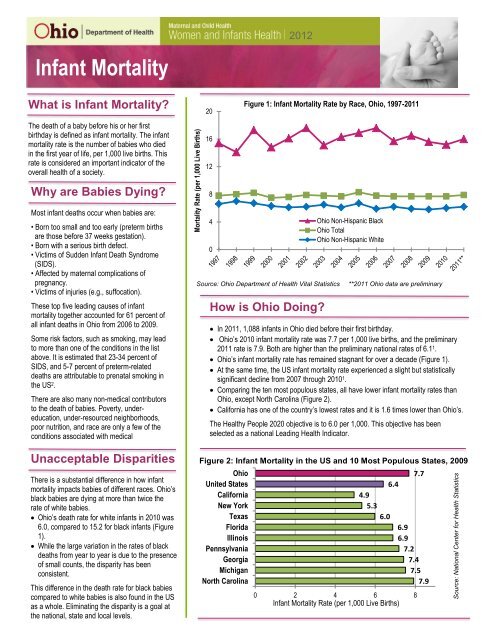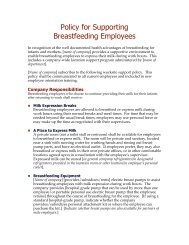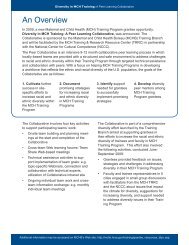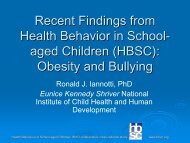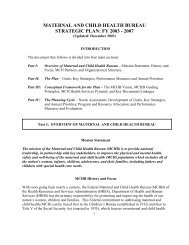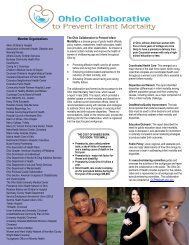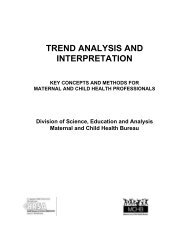Ohio Infant Mortality Fact Sheet - Maternal and Child Health Bureau
Ohio Infant Mortality Fact Sheet - Maternal and Child Health Bureau
Ohio Infant Mortality Fact Sheet - Maternal and Child Health Bureau
You also want an ePaper? Increase the reach of your titles
YUMPU automatically turns print PDFs into web optimized ePapers that Google loves.
<strong>Mortality</strong> Rate (per 1,000 Live Births)<br />
Source: National Center for <strong>Health</strong> Statistics<br />
2012<br />
<strong>Infant</strong> <strong>Mortality</strong><br />
What is <strong>Infant</strong> <strong>Mortality</strong>?<br />
The death of a baby before his or her first<br />
birthday is defined as infant mortality. The infant<br />
mortality rate is the number of babies who died<br />
in the first year of life, per 1,000 live births. This<br />
rate is considered an important indicator of the<br />
overall health of a society.<br />
Why are Babies Dying?<br />
20<br />
16<br />
12<br />
8<br />
Figure 1: <strong>Infant</strong> <strong>Mortality</strong> Rate by Race, <strong>Ohio</strong>, 1997-2011<br />
Most infant deaths occur when babies are:<br />
• Born too small <strong>and</strong> too early (preterm births<br />
are those before 37 weeks gestation).<br />
• Born with a serious birth defect.<br />
• Victims of Sudden <strong>Infant</strong> Death Syndrome<br />
(SIDS).<br />
• Affected by maternal complications of<br />
pregnancy.<br />
• Victims of injuries (e.g., suffocation).<br />
These top five leading causes of infant<br />
mortality together accounted for 61 percent of<br />
all infant deaths in <strong>Ohio</strong> from 2006 to 2009.<br />
Some risk factors, such as smoking, may lead<br />
to more than one of the conditions in the list<br />
above. It is estimated that 23-34 percent of<br />
SIDS, <strong>and</strong> 5-7 percent of preterm-related<br />
deaths are attributable to prenatal smoking in<br />
the US 2 .<br />
There are also many non-medical contributors<br />
to the death of babies. Poverty, undereducation,<br />
under-resourced neighborhoods,<br />
poor nutrition, <strong>and</strong> race are only a few of the<br />
conditions associated with medical<br />
consequences that increase the risk of infant<br />
mortality.<br />
Unacceptable Disparities<br />
There is a substantial difference in how infant<br />
mortality impacts babies of different races. <strong>Ohio</strong>’s<br />
black babies are dying at more than twice the<br />
rate of white babies.<br />
<strong>Ohio</strong>’s death rate for white infants in 2010 was<br />
6.0, compared to 15.2 for black infants (Figure<br />
1).<br />
While the large variation in the rates of black<br />
deaths from year to year is due to the presence<br />
of small counts, the disparity has been<br />
consistent.<br />
This difference in the death rate for black babies<br />
compared to white babies is also found in the US<br />
as a whole. Eliminating the disparity is a goal at<br />
the national, state <strong>and</strong> local levels.<br />
4<br />
0<br />
Source: <strong>Ohio</strong> Department of <strong>Health</strong> Vital Statistics<br />
How is <strong>Ohio</strong> Doing?<br />
In 2011, 1,088 infants in <strong>Ohio</strong> died before their first birthday.<br />
<strong>Ohio</strong>’s 2010 infant mortality rate was 7.7 per 1,000 live births, <strong>and</strong> the preliminary<br />
2011 rate is 7.9. Both are higher than the preliminary national rates of 6.1 1 .<br />
<strong>Ohio</strong>’s infant mortality rate has remained stagnant for over a decade (Figure 1).<br />
At the same time, the US infant mortality rate experienced a slight but statistically<br />
significant decline from 2007 through 2010 1 .<br />
Comparing the ten most populous states, all have lower infant mortality rates than<br />
<strong>Ohio</strong>, except North Carolina (Figure 2).<br />
California has one of the country’s lowest rates <strong>and</strong> it is 1.6 times lower than <strong>Ohio</strong>’s.<br />
The <strong>Health</strong>y People 2020 objective is to 6.0 per 1,000. This objective has been<br />
selected as a national Leading <strong>Health</strong> Indicator.<br />
Figure 2: <strong>Infant</strong> <strong>Mortality</strong> in the US <strong>and</strong> 10 Most Populous States, 2009<br />
<strong>Ohio</strong><br />
United States<br />
California<br />
New York<br />
Texas<br />
Florida<br />
Illinois<br />
Pennsylvania<br />
Georgia<br />
Michigan<br />
North Carolina<br />
<strong>Ohio</strong> Non-Hispanic Black<br />
<strong>Ohio</strong> Total<br />
<strong>Ohio</strong> Non-Hispanic White<br />
**2011 <strong>Ohio</strong> data are preliminary<br />
4.9<br />
5.3<br />
6.0<br />
6.4<br />
7.7<br />
6.9<br />
6.9<br />
7.2<br />
7.4<br />
7.5<br />
7.9<br />
0 2 4 6 8<br />
<strong>Infant</strong> <strong>Mortality</strong> Rate (per 1,000 Live Births)
Figure 3: Smoking During the Last 3 Months of Pregnancy, By Demographics, <strong>Ohio</strong>, 2009-2010<br />
What is Being Done in <strong>Ohio</strong> to Prevent <strong>Infant</strong> Deaths?<br />
The <strong>Ohio</strong> Collaborative to Prevent <strong>Infant</strong> <strong>Mortality</strong> (OCPIM) http://tinyurl.com/<strong>Ohio</strong>CPIM , a diverse group of public health officials, policy<br />
makers, advocates, providers, <strong>and</strong> other stakeholders, formed in 2009 to prevent infant mortality throughout <strong>Ohio</strong>.<br />
o Workgroups to address specific issues include coordinated healthcare, disparities/racism, data/metrics/quality improvement,<br />
education/outreach <strong>and</strong> public policy<br />
<strong>Ohio</strong> has accepted the Association of State <strong>and</strong> Territorial <strong>Health</strong> Official’s (ASTHO) President’s Challenge, the <strong>Health</strong>y Babies Initiative, to<br />
improve birth outcomes by reducing infant mortality <strong>and</strong> prematurity in the US. The goal is to decrease prematurity by 8 percent by 2014.<br />
The <strong>Ohio</strong> Department of <strong>Health</strong> <strong>and</strong> Medicaid have joined together to form a state team to participate in HRSA’s Collaborative Improvement<br />
<strong>and</strong> Innovation Network (COIIN) along with other states in our region. COIIN provides a platform across state lines to facilitate collaborative<br />
learning <strong>and</strong> adoption of proven quality improvement principles <strong>and</strong> practices.<br />
The Governor’s Office of <strong>Health</strong> Transformation is investing $350,000 to create a “Community HUB” to ensure care coordination for highrisk<br />
expectant mothers in Southeast <strong>Ohio</strong>. A low birth weight/prematurity pathway was developed in collaboration with OCPIM.<br />
Evidence-based smoking cessation counseling has been supported in WIC clinics <strong>and</strong> CFHS prenatal direct care sites, where almost 30<br />
percent of expectant mothers smoke.<br />
The state <strong>and</strong> partners are developing a comprehensive media campaign to spread a unified message to decrease SIDS <strong>and</strong> other sleep<br />
related infant deaths in <strong>Ohio</strong>, which account for the majority of infant deaths after the 28 th day of life. The messages being spread include<br />
the following:<br />
o Place infants for sleep wholly on the back for every sleep, nap time <strong>and</strong> night time.<br />
o Use a firm sleep surface. A firm crib mattress is the recommended surface.<br />
o Room sharing without bed sharing is recommended. The infant’s crib should be in the parents’ bedroom, close to the<br />
parents’ bed.<br />
o Keep soft objects, loose bedding <strong>and</strong> bumper pads out of the crib.<br />
o Do not smoke during pregnancy. Avoid exposure to secondh<strong>and</strong> smoke.<br />
<strong>Ohio</strong> has exp<strong>and</strong>ed Medicaid eligibility for family planning services to women <strong>and</strong> men who are otherwise ineligible for the program.<br />
New changes allow a child or pregnant woman to receive medical care covered by Medicaid while their application is officially processed.<br />
<strong>Infant</strong> mortality is one of four health improvement priorities in <strong>Ohio</strong>’s state health improvement plan, which was finalized by ODH <strong>and</strong> partners<br />
from across the state in 2012.<br />
Researchers found that infants born to women who conceived less than six months after giving birth had a significantly higher risk for being<br />
born prematurely <strong>and</strong> of having a low birth weight, compared with infants born to mothers who waited 18 months to two years between<br />
pregnancies.<br />
The <strong>Ohio</strong> Perinatal Quality Collaborative (OPQC) is a statewide, multi-stakeholder network dedicated to improving perinatal health in<br />
<strong>Ohio</strong>. 4 Successes <strong>and</strong> new quality improvement initiatives include the following:<br />
Obstetric<br />
o Efforts to prevent scheduled births prior to 39 weeks of gestational age resulted in an estimated 26,300 births moving from<br />


